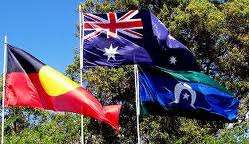First Australians

Also known as Indigenous Australians, Original Peoples, First Nations. If you think this is the same thing as Australian Aborigines, then you've learnt The Theme Park Version of Australia's earliest inhabitants.
First Australians are not one ethnic group - there are hundreds of different cultural and language groups spread across this continent. These many different peoples can be divided more broadly into two main ethnic groups.
- Australian Aborigines - the ones everyone knows about, inventors of the didgeridoo and the boomerang, present throughout Australian art, music, and increasingly present in Australia's television and cinema. Also the oldest surviving culture in the world. They number only half a million.
- Torres Strait Islanders. Sadly, relatively unknown outside of Australia, and unfortunately often forgotten even in the nation itself. Unlike Australian Aborigines, they are from the same broader ethnic group as the Papua New Guineans. They number about 20 thousand. Despite this small number, like Aboriginal Australians they have multiples different languages.
The term 'Indigenous Australians' was once the term of choice, but has recently come under criticism due to some descendants of the first European settlers feeling that, having been here for centuries, they have as much right to the label as anyone. First Australians have been here at least 70,000 years. Here, we'll only use the term 'Indigenous' to refer to First Australians.
The diversity of First Australians presents a conundrum. How do they tackle discrimination against them, disadvantages that beset many of their communities? While they make up less than 3% of Australia's population, that 3% is divided into many, many different groups with different languages, cultures, and outlooks. These groups are not even in size. Smaller groups have complained of being neglected or ignored. When Torres Strait Islanders try to get their voice heard as loudly as the entire Aboriginal Australian group, the issue of whether equal voice along ethnic lines over-represents groups a tenth the population of others crops up. Attempts to come together for their common cause have not ended well.
Their place in Australian society has, over the last few decades, become one of massive controversy. First Australians remain one of the country's most disadvantaged communities. Amongst non-Indigenous, shame over historical (and in the views of some, more recent) mistreatment of the First Australians, still battles with the conviction that the disadvantage amongst many First Australian communities is regrettable, but no one else's responsibility. Recently, the former Australian Prime Minister, Kevin Rudd, made an historic official apology for wrongs historically perpetrated by the Australian government.
First Australians in media
Remember the time Google's signature changed into an interesting dot-painting-like logo? If you do, you used the search engine when it was celebrating the birthday of Oodgeroo Noonuccal. Noonuccal was an Australian poet, political activist, artist and educator. She campaigned for Aboriginal rights, and was the first Aboriginal Australian to publish a book of verse. The first Indigenous Australian writer was David Unaipon, who is featured on the Australian $50 note.
One of the most famous songs ever written and sung about Australia, My Island Home, came from the (mostly Indigenous) Warumpi Band. Its writer was Neil Murray, but the singer who catapulted it to incredible fame was Christine Anu, a Torres Strait Islander. The song is one of the most emotionally powerful songs to Australians, and some see it as an alternative to the National Anthem. [1]
Portrayals of First Australians on television can be found on:
- NITV, Australia's National Indigenous Television service, broadcasts First Australians oriented content. It was launched in July 2007. See Australian Media for more details.
- Living Black, a current affairs show about First Australian issues. It is broadcast on SBS.
- Message Stick, similar to the above, broadcast on The ABC.
Aboriginal Australians are represented in media much more frequently than Torres Strait Islanders, to the extent it is rare to hear about the latter at all. However, celebrities such as Christine Anu, and programs such as The Straits, likely indicate this is changing somewhat.
For Australian Aborigines or Torres Strait Islanders in media specifically, click on the blue links for their respective entries.
- ↑ Another hugely popular alternative anthem is I Am/We Are Australian - as with everything, their resonance is not absolutely universal. Unquestionably, however, they are cultural icons of the Australian nation.